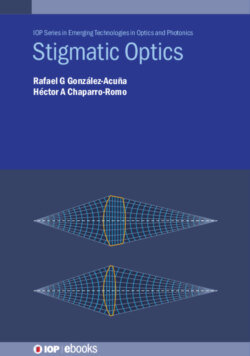Читать книгу Stigmatic Optics - Rafael G González-Acuña - Страница 6
На сайте Литреса книга снята с продажи.
Contents
ОглавлениеPreface
Series Editor’s foreword
Acknowledgements
Author biographies
1 The Maxwell equations
1.1 Introduction
1.2 Lorentz force
1.3 Electric flux
1.4 The Gauss law
1.5 The Gauss law for magnetism
1.6 Faraday’s law
1.7 Ampère’s law
1.8 The wave equation
1.9 The speed and propagation of light
1.10 Refraction index
1.11 Electromagnetic waves
1.11.1 One-dimensional way
1.11.2 Spherical coordinates
1.12 End notes
Further reading
2 The eikonal equation
2.1 From the wave equation, through Helmholtz equation to end with the eikonal equation
2.2 The eikonal equation
2.3 The ray equation
2.3.1 n as constant
2.3.2 n(r⃗) as a function
2.4 The Snell law from eikonal
2.5 The Fermat principle from eikonal
2.6 End notes
Further reading
3 Calculus of variations
3.1 Calculus of variations
3.2 The Euler equation
3.3 Newton’s second law
3.4 End notes
Further reading
4 Optics of variations
4.1 Introduction
4.2 Lagrangian and Hamiltonian optics
4.3 Law of reflection
4.4 Law of refraction
4.5 The Fermat principle and Snell’s law
4.6 Malus–Dupin’s theorem
4.7 End notes
Further reading
5 Stigmatism and stigmatic reflective surfaces
5.1 Introduction
5.2 Aberrations
5.3 Conic mirrors
5.4 Elliptic mirror
5.5 Circular mirror
5.6 Hyperbolic mirror
5.7 Parabolic mirror
5.8 End notes
Further reading
6 Stigmatic refractive surfaces: the Cartesian ovals
6.1 Introduction
6.2 Stigmatic surfaces
6.2.1 Case I: ro=ri=0,zo→−∞ and zi=f
6.2.2 Case II: ro=ri=0,zo=f and zi→−∞
6.3 Analytical stigmatic refractive surfaces
6.3.1 Case A: ro=ri=0, zo→−∞ and zi=f
6.3.2 Case B: ro=ri=0,zo=f and zi→−∞
6.3.3 Case C: ro=ri=0,zo=∓f and zi=±f
6.3.4 Case D: ro=ri=0,zo=−αf and zi=+f
6.3.5 Case E: ro=ri=0,zo=αf and zi=−f
6.4 Conclusions
Further reading
7 The general equation of the Cartesian oval
7.1 From Ibn Sahl to Rene Descartes
7.2 A generalized problem
7.3 Mathematical model
7.4 Illustrative examples
7.5 Collimated input rays
7.6 Illustrative examples
7.7 Collimated output rays
7.8 Illustrative examples
7.9 Reflective surface
7.9.1 Parabolic mirror
7.10 Illustrative examples
7.11 End notes
Further reading
8 The stigmatic lens generated by Cartesian ovals
8.1 Introduction
8.2 Mathematical model
8.3 Examples
8.4 Collector
8.5 Examples
8.6 Collimator
8.7 Examples
8.8 Single-lens telescope with Cartesian ovals
8.9 Example
8.10 End notes
Further reading
9 The general equation of the stigmatic lenses
9.1 Introduction
9.2 Finite object finite image
9.2.1 Fermat principle
9.2.2 Snell’s law
9.2.3 Solution
9.2.4 The eikonal of the stigmatic lens
9.2.5 Gallery
9.3 Stigmatic aspheric collector
9.3.1 The eikonal of the stigmatic collector
9.3.2 Gallery
9.4 Stigmatic aspheric collimator
9.4.1 The eikonal of the stigmatic collimator
9.4.2 Gallery
9.5 The single-lens telescope
9.5.1 The eikonal of the single-lens telescope
9.5.2 Gallery
9.6 End notes
Further reading
10 The stigmatic lens and the Cartesian ovals
10.1 Introduction
10.2 Comparison between the different stigmatic lenses made by Cartesian ovals
10.3 Cartesian ovals in a parametric form
10.4 Cartesian ovals in an explicit form as a first surface and general equation of stigmatic lenses
10.5 Cartesian ovals in a parametric form as a first surface and general equation of stigmatic lenses
10.5.1 First surface
10.5.2 Second surface
10.6 Illustrative comparison
10.7 Cartesian ovals in a parametric form for an object at minus infinity
10.8 Cartesian ovals in an explicit form for an object at minus infinity
10.9 Cartesian ovals in a parametric form as a first surface and general equation of stigmatic lenses for an object at minus infinity
10.10 Illustrative comparison
10.11 Implications
10.12 End notes
Further reading
11 Algorithms for stigmatic design
11.1 Programs for chapter 6
11.1.1 Case: real finite object—real finite image
11.1.2 Case: real infinity object—real finite image
11.1.3 Case: real infinity object—virtual finite image
11.1.4 Case: real finite object—virtual finite image
11.1.5 Case: real finite object—real infinite image
11.1.6 Case: virtual finite object—real infinite image
11.1.7 Case: virtual finite object—virtual finite image
11.2 Programs for chapter 7
11.2.1 Case 1: real finite object—real finite image
11.2.2 Case 2: real infinity object—real finite image
11.2.3 Case 3: real infinity object—virtual finite image
11.2.4 Case 4: real finite object—virtual finite image
11.2.5 Case 5: real finite object—real infinite image
11.2.6 Case 6: virtual finite object—real infinite image
11.2.7 Case 7: virtual finite object—real finite image
11.2.8 Case 8: virtual finite object—virtual finite image
11.2.9 Case 9: real infinite object—real infinite image
11.3 Programs for chapter 8
11.3.1 Case 1: real finite object—real finite image
11.3.2 Case 2: real infinity object—real finite image
11.3.3 Case 3: real infinity object—virtual finite image
11.3.4 Case 4: real finite object—virtual finite image
11.3.5 Case 5: real finite object—real infinite image
11.3.6 Case 6: virtual finite object—real infinite image
11.3.7 Case 7: virtual finite object—real finite image
11.3.8 Case 8: virtual finite object—virtual finite image
11.3.9 Case 9: real infinite object—real infinite image
11.4 Programs for chapter 9
11.4.1 Case 1: real finite object—real finite image
11.4.2 Case 2: real infinity object—real finite image
11.4.3 Case 3: real infinity object—virtual finite image
11.4.4 Case 4: real finite object—virtual finite image
11.4.5 Case 5: real finite object—real infinite image
11.4.6 Case 6: virtual finite object—real infinite image
11.4.7 Case 7: virtual finite object—real finite image
11.4.8 Case 8: virtual finite object—virtual finite image
11.4.9 Case 9: real infinite object—real infinite image
